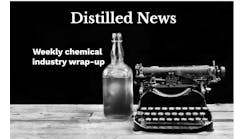Welcome to this week’s edition of Distilled News, a Chemical Processing production where we review some of the latest articles trending on ChemicalProcessing.com. I’m your host, Jonathan Katz, executive editor of Chemical Processing magazine.
The U.S. Environmental Protection Agency has been busy the past week with several announcements that impact the chemical industry.
On March 18, a decades-long battle to ban asbestos in the United States concluded when the U.S. Environmental Protection Agency (EPA) said it would prohibit its remaining uses, marking the first regulation to be finalized under 2016 revisions to the Toxic Substances Control Act.
Under the ruling, the EPA has outlawed uses of chrysotile asbestos, the last known form of the material currently in use within the U.S.
Some of the current uses for chrysotile asbestos include asbestos diaphragms, sheet gaskets, brake blocks and aftermarket automotive brakes/linings. The chlor-alkali sector uses asbestos diaphragms to make sodium hydroxide and chlorine to disinfect drinking water and wastewater.
The eight remaining chlor-alkali facilities that use asbestos must transition to either non-asbestos diaphragms or to non-asbestos membrane technology.
Companies that are transitioning multiple facilities to non-asbestos membrane technology have five years to convert their first facility, eight years to convert their second plant and 12 years to convert their third facility. The EPA is requiring the facilities to certify their continued progress with the agency.
Asbestos, once commonly used in insulation, has been linked to more than 40,000 cancer-related deaths per year.
On March 14, the agency said it would tighten ethylene oxide (EtO) emissions rules for facilities that use the chemical to sterilize medical devices.
The agency announced these amendments under the Clean Air Act standards for hazardous air pollution emissions on March 14 as part of the President Biden’s ongoing environmental justice initiative. The final rule includes requirements for air-pollution controls that will cut emissions by more than 90% at commercial sterilization facilities, the EPA said in a news release.
This final rule for commercial sterilizers is one of several actions the EPA is taking to reduce EtO exposure. The agency is currently working on a rule to strengthen EtO standards in chemical facilities.
The amendments will address emissions at nearly 90 commercial sterilization facilities owned and operated by approximately 50 companies.
The final rule includes new standards for unregulated emissions like building leaks and chamber exhaust vents, stronger standards for sterilization chamber vents and aeration room vents and requirements for continuous emissions monitoring and quarterly reporting. Sterilizers will also be subject to emission standards during startup, shutdown and malfunction periods to ensure continuous clean air protection. Other updates include technical and electronic reporting revisions.
To address sustainability and safety issues, chemical manufacturers continue to announce new innovations using new formulations and materials.
Toray Industries Inc. said March 10 that it has developed an ion-conductive polymer membrane that solves a key capacity issue in batteries.
The development delivers 10 times the ion conductivity of alternative methods, according to the company.
Metallic lithium anodes employing solid electrolytes pose similar hurdles, according to Toray.
The company said it found a solution to these problems using polymer membranes that provide ion conductivity through a process called hopping conduction. “This mechanism enables lithium ions to move between interacting sites within nonporous polymer membranes,” the company said in a news release.
This new offering could accelerate the deployment of solid-state batteries, air batteries and lithium-metal batteries, the company said.
And Shell Chemicals will supply Braskem with propylene feedstocks partially sourced from biobased materials.
Braskem said March 15 it will use the feedstocks to produce bio-attributed and bio-circular polypropylene.
The feedstocks will satisfy growing consumer demand for more sustainable options in packaging, film, automotive and consumer goods, the company said.
The feedstocks have been third-party certified using the mass-balance approach, a sustainability measurement that allows for the blending of biobased and non-sustainable material.
And finally, humidity is bad for hair but is it good for carbon capture? A
team at Princeton University has developed a material capable of capturing and releasing carbon dioxide from the atmosphere using humidity fluctuations, a process significantly more energy-efficient than traditional methods, according to a March 14 news release. The material, based on modified ion-exchange resin, operates by adsorbing CO2 in low humidity and releasing it in high humidity.
The Princeton team's research, published in Environmental Science & Technology Letters, showcases the potential of leveraging humidity for carbon capture, presenting a more sustainable and cost-effective solution. By incorporating basic ions into the resin's pores, the researchers achieved optimal carbon capture capacity. They also found that larger pores enhance capture rates, crucial for scaling up the technology. Additionally, the material's low energy requirements and inexpensive components make it a promising candidate for large-scale implementation. The technology could capitalize on natural humidity fluctuations, offering energy-efficient operation in environments with varying moisture levels.
That’s it for this week’s edition of Distilled News.
Visit chemicalprocessing.com for more insights, and don't forget to register for our Morning Briefing and Chemical Processing Weekly newsletters. Until next time, stay informed, stay inspired, and let's shape the future of chemistry together. Thank you, and goodbye.



